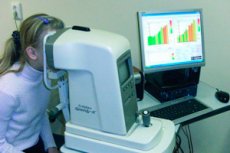Medical expert of the article
New publications
Methods of accommodation research
Last reviewed: 07.07.2025

All iLive content is medically reviewed or fact checked to ensure as much factual accuracy as possible.
We have strict sourcing guidelines and only link to reputable media sites, academic research institutions and, whenever possible, medically peer reviewed studies. Note that the numbers in parentheses ([1], [2], etc.) are clickable links to these studies.
If you feel that any of our content is inaccurate, out-of-date, or otherwise questionable, please select it and press Ctrl + Enter.

It is necessary to distinguish between absolute and relative accommodation.
Absolute accommodation is the accommodation of one (isolated) eye when the other is excluded from the act of vision. The mechanism of relative accommodation involves the accommodation of both eyes simultaneously when fixating a common object.
Absolute accommodation is characterized by two points on the visual axis: the further point of clear vision PR (punctum remotum) and the nearest point of clear vision PP (punctum proximum). PR is the point of best vision in space, the position of which actually depends on clinical refraction. PP is the point of best vision at close range at maximum accommodation tension. Thus, the volume of absolute accommodation can be calculated using the formula:
A = R - PP,
Where A is the volume of absolute accommodation, R is the clinical refraction, PP is the closest point of clear vision (all values are in diopters). The refraction of points close to the eye is usually denoted with the "-" sign, since these points conventionally correspond to myopic refraction. For example, with a clinical refraction equal to myopia - 1.0 D, and the closest point of clear vision located 20 cm from the eye, the volume of absolute accommodation will be:
A=-1.0-(-1/0.2) =-1.0-(-5.0)=6.0 (dptrs).
Approximate age norms of relative accommodation reserve (A)
Age, years |
A, dptr |
7-9 |
3 |
10-12 |
4 |
13-20 |
5 |
21-25 |
4 |
26-30 |
3 |
31-35 |
2 |
36-40 |
1 |
41-45 |
0 |
To determine the position of the nearest point of clear vision, special devices (proximeters or accommodometers) are used.
The value of relative accommodation is determined as follows. The patient is asked to read the text of the chart for checking near vision acuity binocularly (i.e. with both eyes). Positive and then negative lenses are inserted into the trial frame sequentially (at intervals of 0.5 D) until the patient can still read. In this case, positive lenses will compensate for the accommodation tension already spent, while negative lenses, on the contrary, will cause this tension. The values of the maximum positive and maximum negative lenses will indicate the negative, i.e. spent, and positive, i.e. remaining in reserve, parts of the relative accommodation, respectively. The sum of these indicators will constitute the volume of relative accommodation.
Ergography is used for an objective assessment of the state of the accommodative apparatus of the eye. The essence of the method is to determine the performance of the ciliary muscle during visual work at close range. The results of the study are recorded in the form of a graphic curve. It is proposed to distinguish 4 types of ergographic curves: the 1st characterizes the normal performance of the ciliary muscle, the rest - an increasing decrease in the accommodative ability.
From a practical point of view, the value of the relative accommodation reserve is of great importance, i.e. the indicator that serves as indirect evidence of the potential capabilities of the accommodation apparatus. There is evidence that a decrease in the log indicator indicates a predisposition to the development of myopia.
For long-term, quiet work at close range, it is necessary that the positive part of the relative accommodation be 2 times greater than the negative.


 [
[